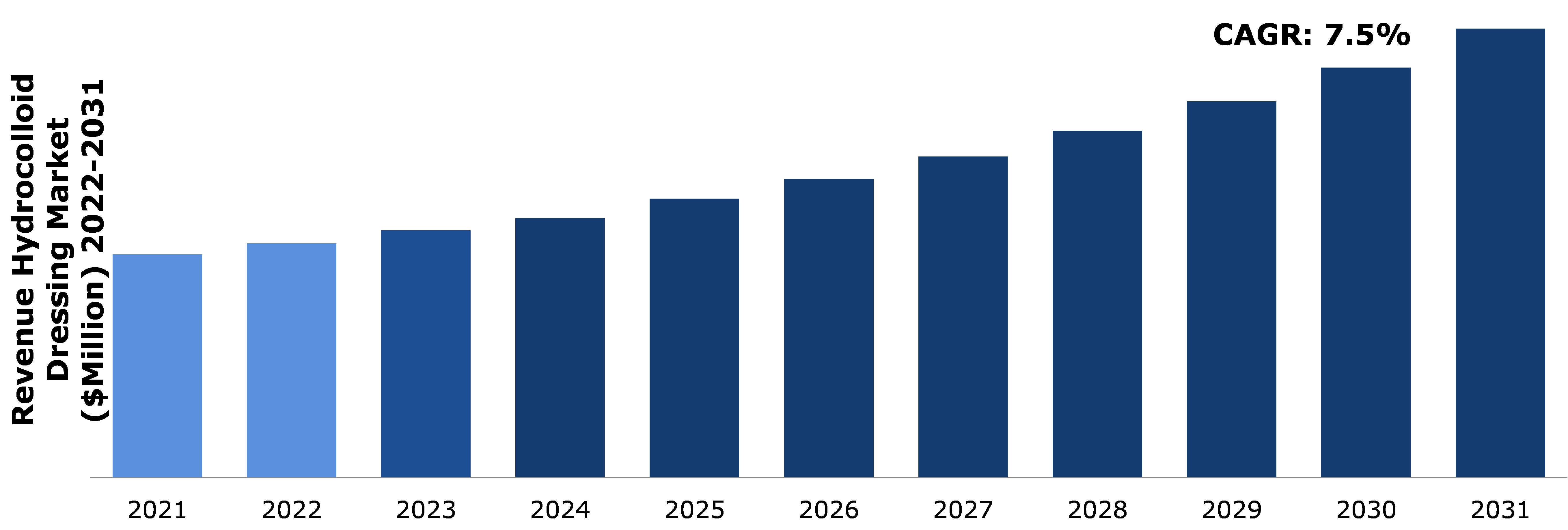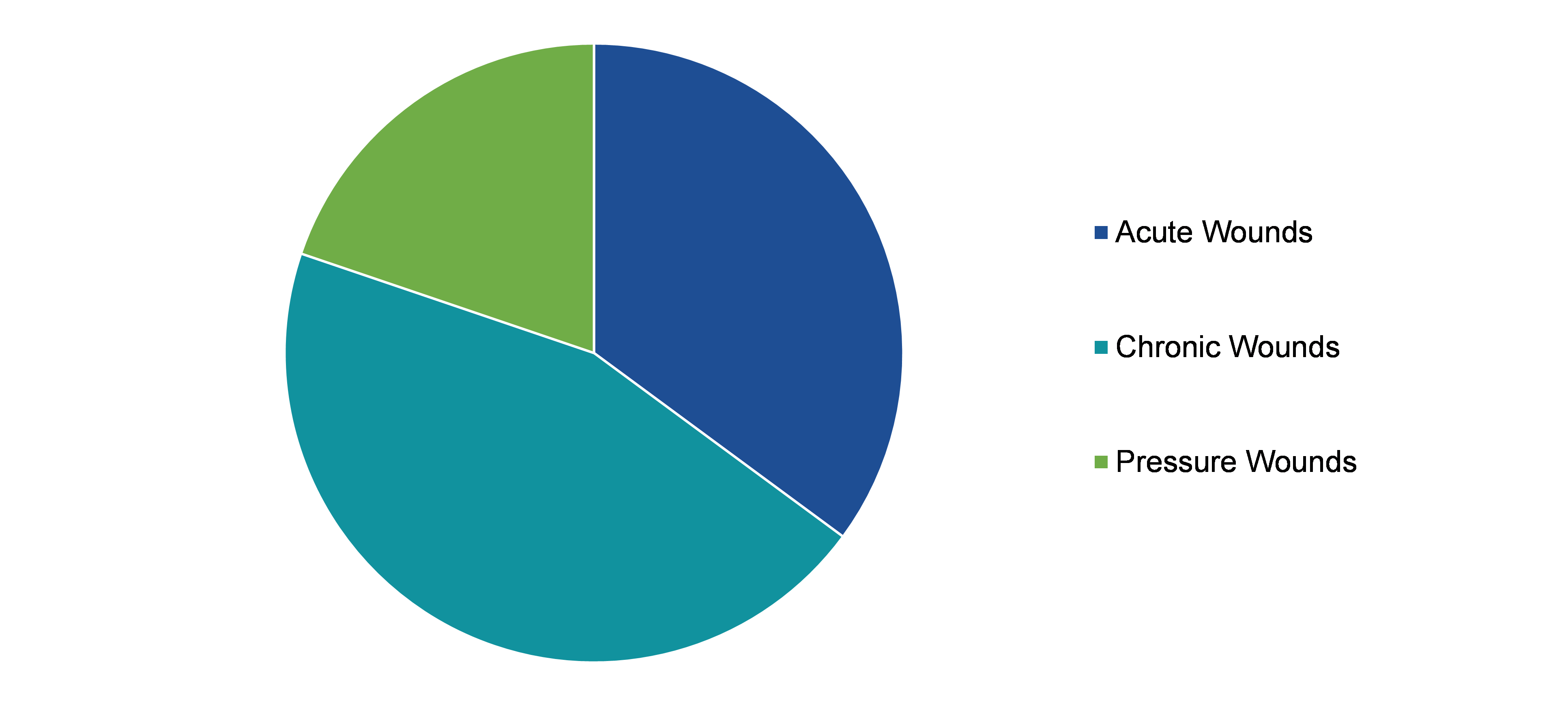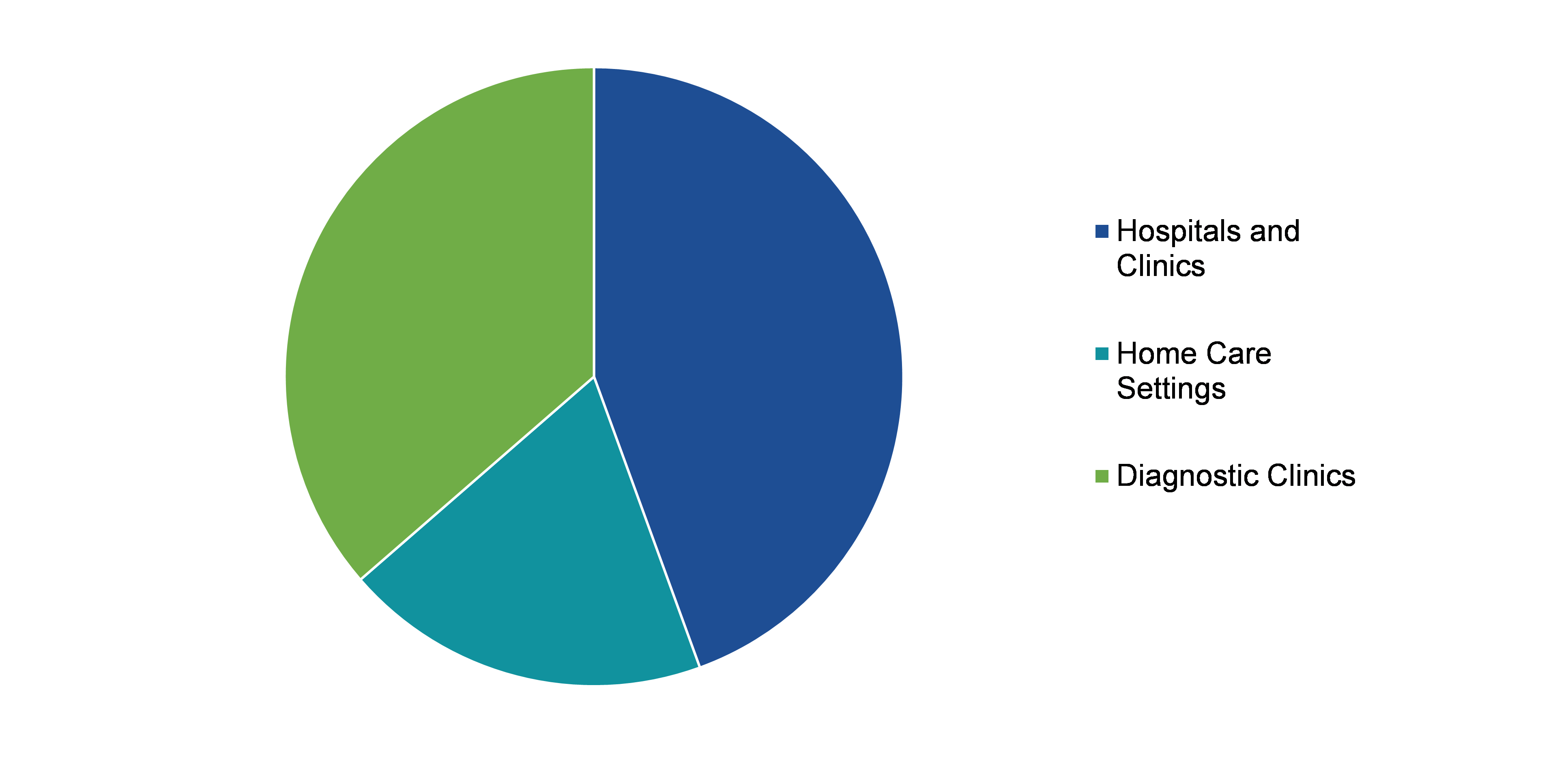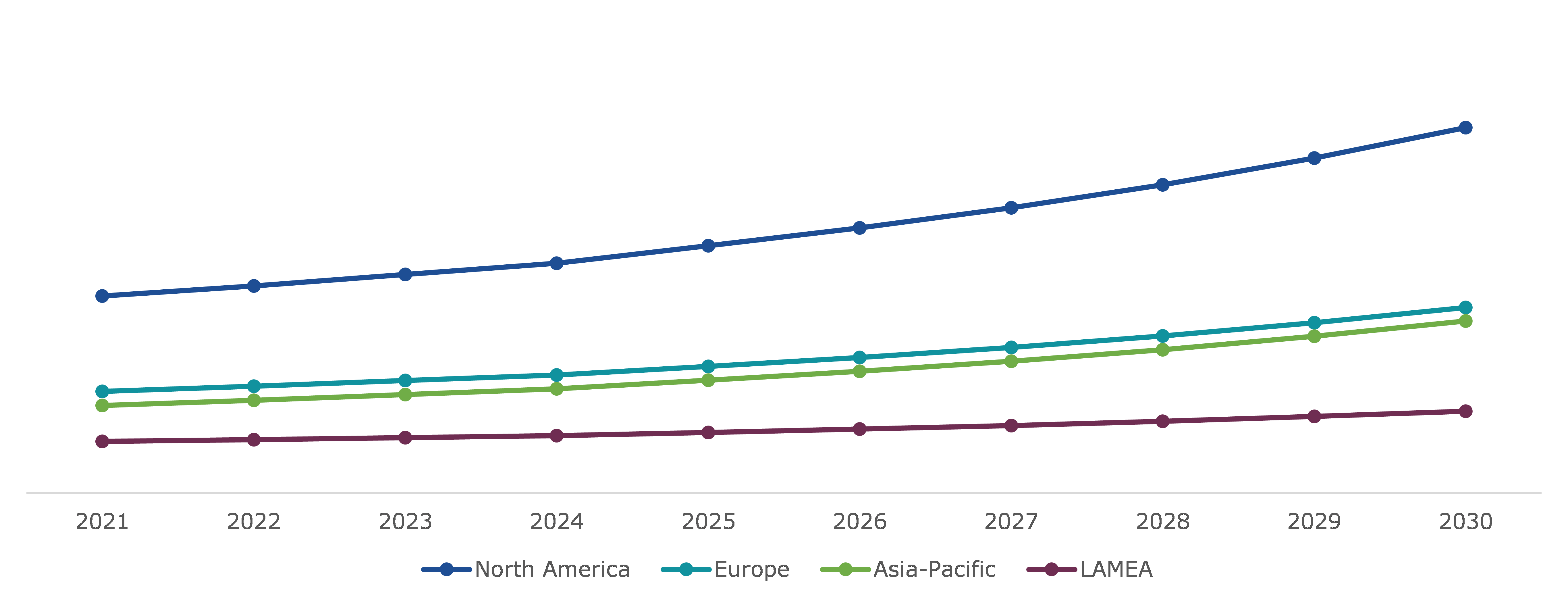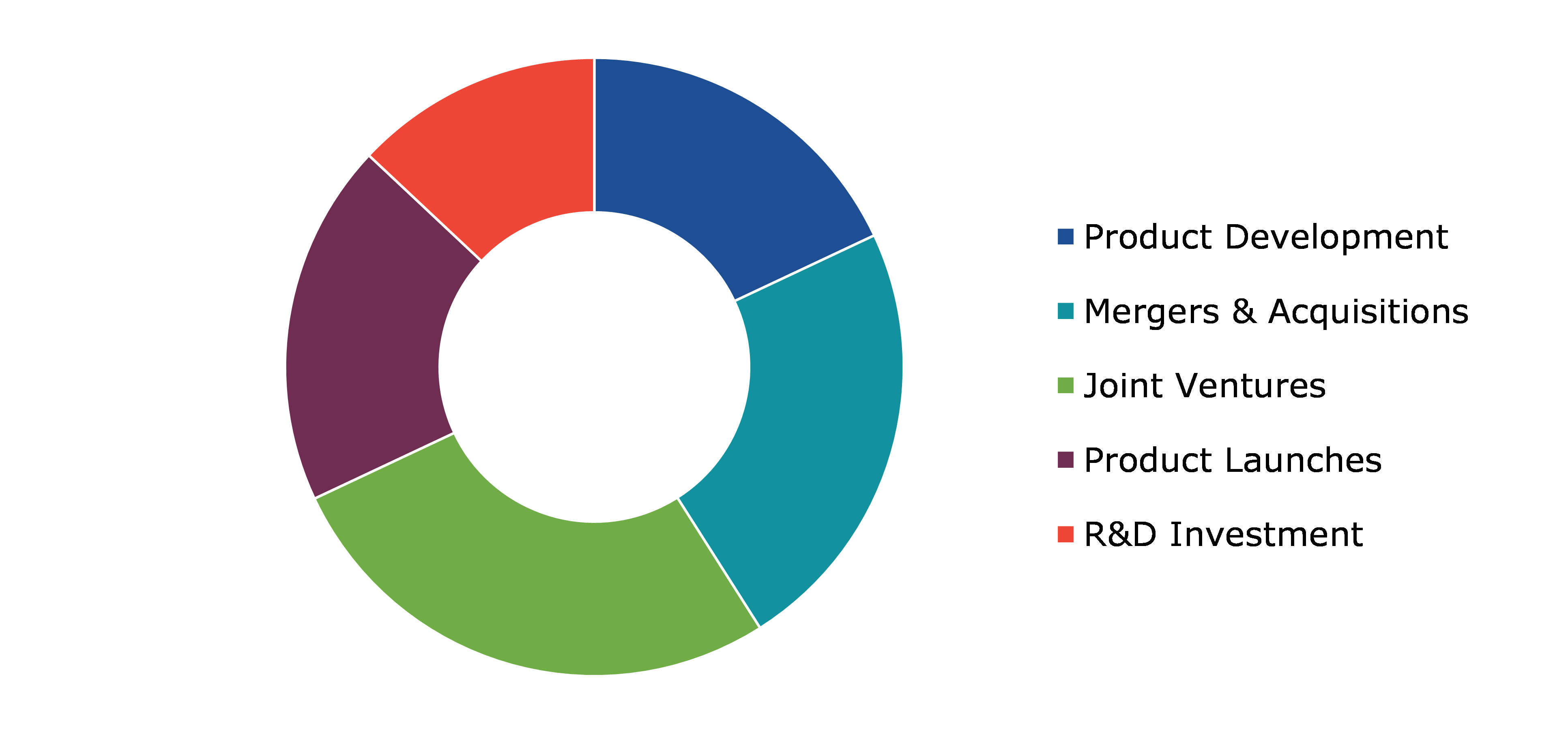Hydrocolloid Dressing Market Report
RA08594
Hydrocolloid Dressing Market by Application (Acute Wound, Chronic Wound, and Pressure Wound), and End User (Hospitals & Clinics, Home Care Settings, and Diagnostic Clinics): Global Opportunity Analysis and Industry Forecast, 2022-2031
Global Hydrocolloid Dressing Market Analysis
The Global Hydrocolloid Dressing Market Size is predicted to be valued at $4,725.9 million by 2031, surging from $2,349.1 million in 2021, at a CAGR of 7.5%.
Global Hydrocolloid Dressing Market Synopsis
Hydrocolloid dressings are wafers, powders, or pastes made of gelatin, pectin, and carboxymethyl-cellulose. They provide a moist environment conducive to wound healing as well as a barrier against foreign microorganisms. The inner layer of hydrocolloid dressings consists of gel-forming substances known as hydrocolloid particles, which include carboxymethylcellulose, gelatin, and pectin. This inner layer aids healing by soaking edema, a form of waste made up of water, white blood cells, and enzymes. This function creates a moist healing environment that promotes quicker healing and lessens the creation of scars.
The use of hydrocolloid dressing in street accidents is becoming more common worldwide. The use of self-adhesive hydrocolloid dressings, which are most probably connected with the treatment of inflammatory disorders such as pressure sores and leg ulcers, may also be beneficial in the management of all forms of wound infection. Hydrocolloid dressings are most typically used to treat inflammatory situations such as pressure injuries and leg wounds, where they have been found to be more effective than cotton dressings in terms of wound repair, pain associated with dressing changes, absorption capacity, adverse effects, and cost. They also help manage a variety of wound infections, including the management of a variety of wound infections, including acute and incomplete thickness burns, surgical wounds, minor trauma, and post-operative pediatrics injuries. The main advantage of using hydrocolloid dressings on burn and donor sites is that they reduce wound discomfort. Such factors are likely to have a positive growth on hydrocolloid dressings market growth in the future.
Hydrocolloid dressings are ineffective for deep or infected wounds because they do not absorb bleeding or microbial infection. They are difficult to keep in place and can get loose. The dressing may adhere to itself, other bandages, or the tissue, making removal difficult. All these factors are anticipated to hamper the hydrocolloid dressing market share during the forecast period.
Knowledge of dressing products and clinical experience in dressing selection are two essential factors in complete wound management that enable evidence-based wound care. With the global market for dressing products expanding, clinician understanding of dressing qualities in wound care needs to be updated. Chronic wounds such as leg ulcers, diabetic ulcers, and pressure injuries are becoming more common around the world as the prevalence of lifestyle disorders rises. The demand for sophisticated wound care therapies for effective treatment is anticipated to fuel the expansion of the hydrocolloid dressing market share as chronic wounds will place a substantial burden on the individual, healthcare system, and society.
According to regional analysis, the North America market is primarily driven by the rise in the prevalence of chronic and acute wounds.
Hydrocolloid Dressing Overview
Hydrocolloid dressing is a type of wound dressing that is used to treat weakly exuding wounds such as minor burns or bed sores. These dressings are waterproof and, unlike other types of dressings, create a moist and insulating environment to assist wound healing. The outer layer, which is waterproof and comprised of polystyrene foam or film, protects the wound from debris, bacteria, and foreign objects. Any bacteria and dirt that may accumulate are caught in the dressing and eliminated when the dressing is changed. As they can be left in place for up to a week, these dressings normally do not need to be changed as frequently as conventional dressings unless they are malodorous, filthy, or saturated.
COVID-19 Impact on Global Hydrocolloid Dressing Market
Several businesses around the globe were forced to shut down due to the COVID-19 pandemic, which resulted in significant financial losses. Supply chain disruptions, closure of manufacturing facilities, and global economic recession, ultimately reduced the hydrocolloid dressing market size. Any procedure or service that was determined to be non-essential was consequently stopped during the pandemic. Many hospitals had previously designated wound treatment as non-essential. Patients with diabetes, hypertension, venous insufficiency, and peripheral artery disease are most vulnerable to COVID-19 infection, which has led to secondary infections, sepsis, amputations, and even death. Also, nonhealing wounds that go untreated and unmanaged owing to a lack of wound care products resulted in infections, sepsis, the need for limb amputation, and even death during the COVID-19 pandemic.
However, the global shutdown impacted the supply chain, significantly reducing the availability of hydrocolloids' raw materials. In addition, COVID-19's effect on logistics resulted in a rise in raw material costs and an increase in the cost of hydrocolloids for producers.
Increase in Prevalence of Severe Burn Injuries to Boost Market Growth
Thermal trauma is one of the most serious and complicated types of trauma and one of the leading causes of disability. Thermal harm can be caused by heat, high-voltage electricity, or chemicals. Burn therapy is a difficult clinical problem. Burns are long-lasting wounds, and many patients have persistent discomfort. Because of their unique qualities, hydrocolloid dressings have been used universally to expedite wound healing and overcome the limitations of traditional treatment modalities. Hydrocolloid dressings are available in a variety of sizes, forms, and specifications and can be utilized on a wide variety of low to moderately leaking burns wounds. They are flexible, conformable, and easy to use. It enables their use in burn injuries and split-thickness skin graft donor sites. Visual inspections of the wound may also be possible with inner, more transparent variants without removing the dressing. Hydrocolloid dressing may also cause less pain during application and removal.
To know more about global hydrocolloid dressing market growth drivers, get in touch with our analysts here.
Concerns about the Development of Infection in Diabetic Patients to Hinder Market Expansion
Diabetes-related chronic wounds present a substantial medical problem. Non-healing complications can have serious effects on patients and cost the healthcare system enormous sums of money every year. Diabetic patients' wounds do not heal because of a confluence of factors that hinder the removal of wounded tissue, promote the growth of healthy cell populations, and raise infection risk. Hydrocolloids with a waterproof backing are not indicated for clinically infected wounds due to their semi-occlusive nature. Prolonged usage of hydrocolloids in moderately to highly leaking wounds may result in hyper granulation. Some studies caution against using hydrocolloids in diabetic foot ulcers because they may promote the growth of anaerobic bacteria. Such factors are likely to restrain hydrocolloid dressings market revenue growth in the anticipated time.
Growing Healthcare Expenditure in Emerging Economies and Rising Demand for Advanced Wound Care to Create Several Growth Opportunities
The need for advanced wound dressing is increasing owing to technological advancements in wound care products, an increase in the number of surgical procedures, and an increase in the number of long-lasting wound diseases. The rise in the prevalence of chronic diseases such as cancer, diabetes, and other autoimmune diseases is fueling the demand for wound dressing such as hydrocolloid dressing. Antimicrobial resistance, the adoption of unhealthy and sedentary lifestyles, and alcohol consumption are all key contributors to the growth in the rise of noncommunicable illnesses. The number of procedures performed has increased as the frequency of chronic illnesses has increased. Thus, the usage of wound care treatments to stop surgical site infections is growing. Most surgical wounds after cancer surgery are relatively wide and deep, generating exudates that must be managed regularly. Advanced wound dressing treatments, such as hydrocolloid dressing and foam, assist in managing large and small wounds, lowering the risk of infection. Thus, the increase in the prevalence of chronic diseases is predicted to increase demand for wound care products, creating several growth opportunities in the hydrocolloid dressing market.
To know more about global hydrocolloid dressing market opportunities, get in touch with our analysts here.
Global Hydrocolloid Dressing Market, by Application
Based on the application, the market has been divided into acute wounds, chronic wounds, and pressure wounds. The chronic wound sub-segment accounted for a dominant market share in 2021.
Global Hydrocolloid Dressing Market Growth, by Application, 2021
Source: Research Dive Analysis
The chronic wound segment accounted for a dominant market share in 2021. Chronic wounds are wounds in which hemostasis, inflammation, proliferation, and remodeling have been interrupted at one or more points throughout the usual healing process. This sort of wound typically has an underlying pathology, which causes a delay in healing. The morbidity and mortality of patients from chronic wounds have increased, placing a financial strain on the entire world. Chronic wounds are frequently treated with hydrocolloid dressings. Using hydrocolloid dressing to treat chronic wounds dramatically improves the patient's condition, according to medical evaluation. All these factors are anticipated to boost the hydrocolloid dressing market share.
Global Hydrocolloid Dressing Market, by End User
By end user, the market is categorized into hospitals & clinics, home care settings, and diagnostic clinics. The hospitals & clinics wound segment accounted for a dominant market share in 2021.
Global Hydrocolloid Dressing Market Outlook, by End User, 2021
Source: Research Dive Analysis
The hospitals & clinics wound segment accounted for a dominant market in 2021. The hospital and clinic wound sector is expected to increase at a rapid rate during the forecast period due to the increase in demand for hydrocolloid dressing services and better wound care products for treating composite wounds. In hospitals and clinics, hydrocolloid dressings are frequently used for surgical wound care. Also, the longer hospital stays of diabetic patients boost demand for hydrocolloid wound dressings in the hospital segment.
Hydrocolloid Dressing Market, Regional Insights
The hydrocolloid dressing market was analyzed across North America, Europe, Asia-Pacific, and LAMEA.
Global Hydrocolloid Dressing Market Size & Forecast, by Region, 2021-2030 (USD Million)
Source: Research Dive Analysis
The Market for Hydrocolloid Dressing in North America to be the Most Dominant
The rise in the prevalence of chronic wounds, higher treatment costs, and the availability of appropriate payment mechanisms in the U.S. and Canada are all factors responsible for the regional dominant market share. This region is likely to maintain its dominance during the forecast period due to an increase in product demand from various end-use industries such as hospitals, ASCs, and home care. Growth in North America is also anticipated to be fueled by an increase in patient awareness levels about wound infections and hygiene along with the rise in healthcare spending. The presence of a large number of important players situated in the U.S. has resulted in strong penetration rates for hydrocolloid dressings across the country, resulting in significant unmet clinical requirements that are now being addressed by innovators through novel dressing technologies, resulting in an increase in adoption rates across North America, favorably influencing overall industry growth rate during the forecast period.
Competitive Scenario in Global Hydrocolloid Dressing Market
Investment and agreement are common strategies followed by major market players. For instance, in March 2022, Proman, the leading petrochemical company, entered into a cooperation agreement with Maersk, the Denmark-based shipping company for the development of green hydrocolloid dressing supply solutions to produce hydrocolloid dressing.
Source: Research Dive Analysis
Some of the leading hydrocolloid dressing market players are Smith Nephew, 3M, Coloplast Corp, Convatec Inc, Cardinal Health, Molnlycke, Inc., INTEGRA, Abbott, Ltd., Medtronic, and Cardinal Health.
| Aspect | Particulars |
| Historical Market Estimations | 2020 |
| Base Year for Market Estimation | 2021 |
| Forecast Timeline for Market Projection | 2022-2031 |
| Geographical Scope | North America, Europe, Asia-Pacific, and LAMEA |
| Segmentation by Application |
|
| Segmentation by End-User |
|
| Key Companies Profiled |
|
Q1. What is the size of the global hydrocolloid dressing market?
A. The size of the global hydrocolloid dressing market was over $2,349.1 million in 2021 and is projected to reach $4,725.9 million by 2031.
Q2. Which are the major companies in the hydrocolloid dressing market?
A. 3M, Smith Nephew, and Coloplast Corp are some of the key players in the global hydrocolloid dressing market.
Q3. Which region, among others, possesses greater investment opportunities in the near future?
A. North America possesses greater investment opportunities for investors in the future.
Q4. What will be the growth rate of the Asia-Pacific hydrocolloid dressing market?
A. Asia-Pacific hydrocolloid dressing market is anticipated to grow at 8.3% CAGR during the forecast period.
Q5. What are the strategies opted by leading players in this market?
A. Agreement and investment are the two key strategies opted by the operating companies in this market.
Q6. Which companies are investing more on R&D practices?
A. Convatec Inc, Cardinal Health, and Molnlycke. are the companies investing more on R&D activities for developing new products and technologies.
1.Research Methodology
1.1.Desk Research
1.2.Real time insights and validation
1.3.Forecast model
1.4.Assumptions and forecast parameters
1.5.Market size estimation
1.5.1.Top-down approach
1.5.2.Bottom-up approach
2.Report Scope
2.1.Market Definition
2.2.Key objectives of the study
2.3.Report Overview
2.4.Market segmentation
2.5.Overview of the impact of COVID-19 on the global Hydrocolloid Dressing market
3.Executive Summary
4.Market Overview
4.1.Introduction
4.2.Growth impact forces
4.2.1.Drivers
4.2.2.Restraints
4.2.3.Opportunities
4.3.Market value chain analysis
4.3.1.List of raw material suppliers
4.3.2.List of manufacturers
4.3.3.List of distributors
4.4.Innovation & sustainability matrices
4.4.1.Technology matrix
4.4.2.Regulatory matrix
4.5.Porter’s five forces analysis
4.5.1.Bargaining power of suppliers
4.5.2.Bargaining power of consumers
4.5.3.Threat of substitutes
4.5.4.Threat of new entrants
4.5.5.Competitive rivalry intensity
4.6.PESTLE analysis
4.6.1.Political
4.6.2.Economical
4.6.3.Social
4.6.4.Technological
4.6.5.Environmental
4.7.Impact of COVID-19 on Hydrocolloid Dressing market
4.7.1.Pre-covid market scenario
4.7.2.Post-covid market scenario
5.Hydrocolloid Dressing Market , by Application
5.1.Overview
5.2.Acute Wound
5.2.1.Definition, key trends, growth factors, and opportunities
5.2.2.Market size analysis, by region
5.2.3.Market share analysis, by country
5.3.Chronic Wound
5.3.1.Definition, key trends, growth factors, and opportunities
5.3.2.Market size analysis, by region
5.3.3.Market share analysis, by country
5.4.Pressure Wound
5.4.1.Definition, key trends, growth factors, and opportunities
5.4.2.Market size analysis, by region
5.4.3.Market share analysis, by country
5.5.Research Dive Exclusive Insights
5.5.1.Market attractiveness
5.5.2.Competition heatmap
6.Hydrocolloid Dressing Market, by End User
6.1.Hospitals & Clinics
6.1.1.Definition, key trends, growth factors, and opportunities
6.1.2.Market size analysis, by region
6.1.3.Market share analysis, by country
6.2.Care Settings
6.2.1.Definition, key trends, growth factors, and opportunities
6.2.2.Market size analysis, by region
6.2.3.Market share analysis, by country
6.3.Diagnostic Clinics
6.3.1.Definition, key trends, growth factors, and opportunities
6.3.2.Market size analysis, by region
6.3.3.Market share analysis, by country
6.4.Research Dive Exclusive Insights
6.4.1.Market attractiveness
6.4.2.Competition heatmap
7.Hydrocolloid Dressing Market, by Region
7.1.North America
7.1.1.U.S.
7.1.1.1.Market size analysis, by Application
7.1.1.2.Market size analysis, by End User
7.1.2.Canada
7.1.2.1.Market size analysis, by Application
7.1.2.2.Market size analysis, by End User
7.1.3.Mexico
7.1.3.1.Market size analysis, by Application
7.1.3.2.Market size analysis, by End User
7.1.4.Research Dive Exclusive Insights
7.1.4.1.Market attractiveness
7.1.4.2.Competition heatmap
7.2.Europe
7.2.1.Germany
7.2.1.1.Market size analysis, by Application
7.2.1.2.Market size analysis, by End User
7.2.2.UK
7.2.2.1.Market size analysis, by Application
7.2.2.2.Market size analysis, by End User
7.2.3.France
7.2.3.1.Market size analysis, by Application
7.2.3.2.Market size analysis, by End User
7.2.4.Spain
7.2.4.1.Market size analysis, by Application
7.2.4.2.Market size analysis, by End User
7.2.5.Italy
7.2.5.1.Market size analysis, by Application
7.2.5.2.Market size analysis, by End User
7.2.6.Rest of Europe
7.2.6.1.Market size analysis, by Application
7.2.6.2.Market size analysis, by End User
7.2.7.Research Dive Exclusive Insights
7.2.7.1.Market attractiveness
7.2.7.2.Competition heatmap
7.3.Asia-Pacific
7.3.1.China
7.3.1.1.Market size analysis, by Application
7.3.1.2.Market size analysis, by End User
7.3.2.Japan
7.3.2.1.Market size analysis, by Application
7.3.2.2.Market size analysis, by End User
7.3.3.India
7.3.3.1.Market size analysis, by Application
7.3.3.2.Market size analysis, by End User
7.3.4.Australia
7.3.4.1.Market size analysis, by Application
7.3.4.2.Market size analysis, by End User
7.3.5.South Korea
7.3.5.1.Market size analysis, by Application
7.3.5.2.Market size analysis, by End User
7.3.6.Rest of Asia Pacific
7.3.6.1.Market size analysis, by Application
7.3.6.2.Market size analysis, by End User
7.3.7.Research Dive Exclusive Insights
7.3.7.1.Market attractiveness
7.3.7.2.Competition heatmap
7.4.LAMEA
7.4.1.Brazil
7.4.1.1.Market size analysis, by Application
7.4.1.2.Market size analysis, by End User
7.4.2.Saudi Arabia
7.4.2.1.Market size analysis, by Application
7.4.2.2.Market size analysis, by End User
7.4.3.UAE
7.4.3.1.Market size analysis, by Application
7.4.3.2.Market size analysis, by End User
7.4.4.South Africa
7.4.4.1.Market size analysis, by Application
7.4.4.2.Market size analysis, by End User
7.4.5.Rest of LAMEA
7.4.5.1.Market size analysis, by Application
7.4.5.2.Market size analysis, by End User
7.4.6.Research Dive Exclusive Insights
7.4.6.1.Market attractiveness
7.4.6.2.Competition heatmap
8.Competitive Landscape
8.1.Top winning strategies, 2021
8.1.1.By strategy
8.1.2.By year
8.2.Strategic overview
8.3.Market share analysis, 2021
9.Company Profiles
9.1.3M
9.1.1.Overview
9.1.2.Business segments
9.1.3.Product portfolio
9.1.4.Financial performance
9.1.5.Recent developments
9.1.6.SWOT analysis
9.2.Smith Nephew
9.2.1.Overview
9.2.2.Business segments
9.2.3.Product portfolio
9.2.4.Financial performance
9.2.5.Recent developments
9.2.6.Coloplast Corp
9.3.Methanex Corporation
9.3.1.Overview
9.3.2.Business segments
9.3.3.Product portfolio
9.3.4.Financial performance
9.3.5.Recent developments
9.3.6.SWOT analysis
9.4.Convatec Inc
9.4.1.Overview
9.4.2.Business segments
9.4.3.Product portfolio
9.4.4.Financial performance
9.4.5.Recent developments
9.4.6.SWOT analysis
9.5.Cardinal Health
9.5.1.Overview
9.5.2.Business segments
9.5.3.Product portfolio
9.5.4.Financial performance
9.5.5.Recent developments
9.5.6.SWOT analysis
9.6.Molnlycke
9.6.1.Overview
9.6.2.Business segments
9.6.3.Product portfolio
9.6.4.Financial performance
9.6.5.Recent developments
9.6.6.SWOT analysis
9.7.INTEGRA
9.7.1.Overview
9.7.2.Business segments
9.7.3.Product portfolio
9.7.4.Financial performance
9.7.5.Recent developments
9.7.6.SWOT analysis
9.8.Abbott
9.8.1.Overview
9.8.2.Business segments
9.8.3.Product portfolio
9.8.4.Financial performance
9.8.5.Recent developments
9.8.6.SWOT analysis
9.9.Medtronic,
9.9.1.Overview
9.9.2.Business segments
9.9.3.Product portfolio
9.9.4.Financial performance
9.9.5.Recent developments
9.9.6.SWOT analysis
9.10.Cardinal Health
9.10.1.Overview
9.10.2.Business segments
9.10.3.Product portfolio
9.10.4.Financial performance
9.10.5.Recent developments
9.10.6.SWOT analysis
Wound management is an important and developing global issue. Impaired wound healing is among the most prevalent diabetes consequences, and it is known to be caused by a number of complex causes. For example, neuropathy, hyperglycaemia, and impaired angiogenesis all contribute to a delay in the healing process after a lesion. Generally, moist wound healing creates a suitable environment for wounds and speeds up healing by controlling wound exudate. As a result, materials for wound dressings that promote moist healing have been designed. The most frequently used dressings nowadays include hydrocolloids.
Hydrocolloid is a wafer-shaped bandage that combines gel-forming ingredients and an adhesive substance fused to a flexible, water-repellent outer layer. Alginate is included in some hydrocolloid dressing formulations to improve absorption. This self-adhesive wafer provides a moist healing environment as well as insulation while utilising the body's water and enzyme to keep the wound bed hydrated for optimum wound healing. The hydrocolloid dressings can be applied to a variety of wound types, and they work best on those with poor to moderate drainage. The global hydrocolloid dressing market is expanding at a rapid pace due to the rising number of diabetic patients, the swiftly growing aging population, and the surge in research and development activities.
Newest Insights in the Hydrocolloid Dressing Market
The increasing occurrence of chronic wounds, such as pressure ulcers and diabetic foot ulcers, among the general population is expected to rise the number of patients needing treatment, thus boosting the use of hydrocolloid dressings. As per a report by Research Dive, the global hydrocolloid dressing market is expected to surpass a revenue of $4,725.9 million in the 2022-2031 timeframe. The North America hydrocolloid dressing market is expected to perceive foremost and dominant growth in the years to come. This region is expected to maintain its dominance during the forecast period due to a surge in need for hydrocolloid dressings from several end-use industries like Ambulatory surgery centers (ASCs), home care, and hospitals.
How are Market Players Responding to the Rising Demand for Hydrocolloid Dressing?
Market players are greatly investing in pioneering research and inventions to cater for the rising demand for advanced hydrocolloid dressing. Some of the foremost players in the hydrocolloid dressing market are 3M, Cardinal Health, Smith Nephew, Convatec Inc, Coloplast Corp, Cardinal Health, INTEGRA, Molnlycke, Inc., Medtronic, Abbott, Ltd., and others. These players are focused on planning and devising tactics such as mergers and acquisitions, collaborations, novel advances, and partnerships to reach a remarkable position in the global market.
For instance,
-
In August 2018, CP Kelco, a nature-based ingredient solutions company, revealed that hydrocolloids can offer solutions for sugar reduction, ambient drinking yoghurts, and more.
- In January 2019, GEMCO Medical, a leading provider of medical products, announced the expansion of the GEMCORE360? brand of advanced wound care products. The GEMCORE360? Advanced Wound Care collection offers dressings to support the healing of all serious and chronic wounds. It includes hydrocolloid dressings, alginate dressings, transparent thin films, foam dressings, silver alginate dressings, and PHMB foam dressings.
- In September 2022, Bioré, a small face-care company, introduced Cover & Conquer matte acne patches as an addition to the renowned pore strip with acne treatment. These acne patches are made using hydrocolloids to eliminate newly evolving or prevailing pimples.
COVID-19 Impact on the Global Hydrocolloid Dressing Market
The unpredicted rise of the coronavirus pandemic in 2020 has adversely impacted the global hydrocolloid dressing market. During the pandemic period, the closure of manufacturing facilities, the global economic recession, and supply chain disruptions, eventually reduced the global market size. Throughout the pandemic, any activity or service that was deemed unnecessary was discontinued. Many hospitals formerly classified wound care as non-essential. Patients with hypertension, diabetes, peripheral artery disease, and venous insufficiency are most prone to COVID-19 infection, which has resulted in secondary infections, amputations, sepsis, and even death. Apart from this, COVID-19's impact on logistics led to an increase in producers' expenses for hydrocolloids and raw materials. All these factors significantly hindered the market growth. However, with the relaxation of the pandemic, the global hydrocolloid dressing market is expected to recuperate from incurred losses and grow massively in the upcoming years.
Personalize this research
- Triangulate with your own data
- Request your format and definition
- Get a deeper dive on a specific application, geography, customer or competitor
- + 1-888-961-4454 Toll - Free
- support@researchdive.com

